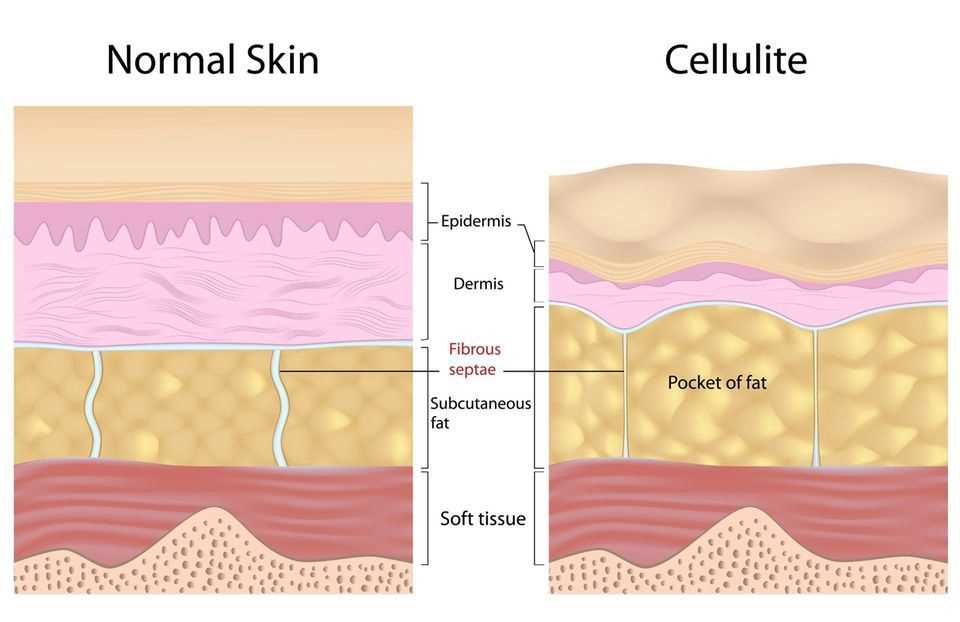Connective tissue weakness
Causes and consequences
© Black_i / Shutterstock
Loose skin and dents that you would like to hide: A weak connective tissue is probably uncomfortable for every woman. But how is it actually created and how can the connective tissue be kept taut?
What is connective tissue weakness?
Our connective tissue consists of elastic fibers and collagen, surrounds the individual organs and holds the structures of the body together. If the elasticity of the tissue decreases, a so-called connective tissue weakness occurs. The result: sagging skin and unsightly dents.
Why do we need the connective tissue?
Stabilize and support
The connective tissue makes up 60 percent of the body’s mass. It surrounds and stabilizes muscles, joints, bones, vessels and organs and acts as a supporting tissue.
Store water and energy
Connective tissue has a high water content and enables oxygen and nutrients to be transported to the organs and muscles that surround it. At the same time, waste products and carbon dioxide can be transported from the oranges. Energy is also stored in the connective tissue – the fatty tissue is primarily responsible for this.
Repel foreign bodies
In the connective tissue there are defense and inflammatory cells that act as a barrier against invading foreign bodies.
What are the causes of a weak connective tissue?
Hormonal fluctuations and physical changes
The female sex hormone estrogen ensures tight connective tissue. During menopause, the production of estrogen decreases, which also causes us to lose a large amount of collagen. Their fibers are responsible for the supporting function of the connective tissue. With fewer collagen fibers, the surface of the skin becomes wavy – we get cellulite, also known as orange peel. The slack tissue is most commonly found on the thighs.
Hormonal changes during puberty can also lead to stretch marks. This mainly happens through growth spurts. But hormonal surges can also be responsible if the young girls develop excessive appetite and overeat. Connective tissue can also weaken during pregnancy – this leads to stretch marks.

A weak connective tissue causes cellulite – i.e. the unsightly dents on the buttocks and thighs.
© Alila Medical Media / Shutterstock
Eating habits
Over-acidification favors a weak connective tissue. Actually, acids are supposed to be transported away through the connective tissue. If the connective tissue is acidic, not all acids can be bound and excreted. Instead, the acid is stored, which weakens the connective tissue. Foods that produce a lot of acid are, for example, meat and dairy products as well as fish.
Diseases as a trigger
A rare but possible cause of connective tissue weakness are diseases such as Marfan’s syndrome. Marfan is a genetic defect that makes connective tissue unstable throughout the body. Affected people often have a narrow build with over-long, overstretchable limbs and crooked teeth. Your risk of heart and vascular disease is also increased.
Medication
Certain drugs, such as cortisone, over-acidify the body and have the same effects as a high-acid diet.
What are the consequences of weak connective tissue?
Varicose veins
Blood congestion in the leg veins increases the pressure on vessels and causes them to swell. This not only causes hardening and reddening of the skin, but also varicose veins and circulatory disorders.
Spider veins
In addition to cellulite, weak connective tissue on the legs can promote spider veins – we can recognize this by fine reddish-blue veins under the skin. Spider veins are not really harmful to health, however, they can be a warning sign of deeper-lying varicose veins.
Uterine subsidence
The pelvic floor tissue in the vagina is usually tight, supporting the bladder and uterus. However, over time, the uterus sinks as the tissues weaken.
What helps with a weak connective tissue?
If there is a weak connective tissue, treatment is usually given according to the cause. For example, varicose veins can be pulled. Connective tissue weakness cannot be completely cured.
However, the complexion of the skin can be improved with one’s own lifestyle and curb cellulite. These measures help:
- Sports, preferably endurance sports such as running, at least three times a week for 30 minutes
- Healthy diet with lots of fruit and vegetables, but less sugar and animal fats
- Alternating showers – alternately run warm and cool water over the body three times
- Gentle massages, for example clenching a fist and rocking it back and forth on the thigh with light pressure

